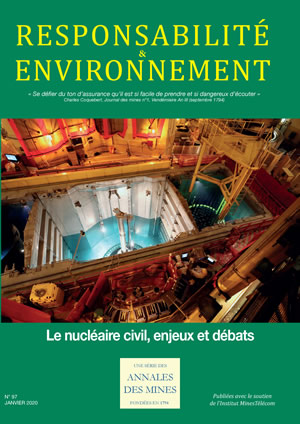|
 N° 97 - Janvier 2020 - Le nucléaire civil, enjeux et débats N° 97 - Janvier 2020 - Le nucléaire civil, enjeux et débats
The Competitiveness of Nuclear Energy: From LCOE to System Costs
By Jan Horst KEPPLER
Senior Economist
Division of Nuclear Technology Development and Economics, OECD Nuclear Energy Agency
and
Marco COMETTO
Nuclear Energy Analyst
Division of Nuclear Technology Development and Economics, OECD Nuclear Energy Agency
Economists used to compare the costs of electricity based on the discounted average lifetime costs of power plants, a metric known as the levelised costs of electricity (LCOE). This transparent and comparatively simple metric worked well in a context of regulated markets. Nuclear, coal, gas and hydro thus competed based on their respective capital, labour and fuel costs at the level of the individual plant. Three forces compel a move away from LCOE. First, the social costs of CO2 and local pollutants are becoming an important decision criterion. Second, the liberalisation of electricity markets introduces price and market risk as a dimension of investor cost. Third, the rise of variable renewable energies (VRE) such as wind and solar PV requires new costs metrics, as the system needs to back up variable resources with added capacity of dispatchable plants. A study by the OECD Nuclear Energy Agency (NEA) shows that integrating system effects increases the costs of a MWh produced by VREs up to USD 50 when they have a 75% share. While precise amounts vary with penetration and flexibility resources, policymakers need to understand that the presence of VRE requires a new notion of competitiveness that includes system effects.
 Télécharger gratuitement l'article Télécharger gratuitement l'article
 Retour au sommaire Retour au sommaire
 N° 97 - January 2020 -Civilian nuclear power: Issues and debates N° 97 - January 2020 -Civilian nuclear power: Issues and debates
The Competitiveness of Nuclear Energy: From LCOE to System Costs
Jan Horst Keppler,
Senior Economist, Division of Nuclear Technology Development and Economics, OECD Nuclear Energy Agency,
&
Marco Cometto,
Nuclear Energy Analyst, Division of Nuclear Technology Development and Economics, OECD Nuclear Energy Agency
Economists used to compare the costs of electricity based on the discounted average lifetime costs of power plants, a metric known as the levelised costs of electricity (LCOE). This transparent and comparatively simple metric worked well in a context of regulated markets. Nuclear, coal, gas and hydro thus competed based on their respective capital, labour and fuel costs at the level of the individual plant. Three forces compel a move away from LCOE. First, the social costs of CO2 and local pollutants are becoming an important decision criterion. Second, the liberalisation of electricity markets introduces price and market risk as a dimension of investor cost. Third, the rise of variable renewable energies (VRE) such as wind and solar PV requires new costs metrics, as the system needs to back up variable resources with added capacity of dispatchable plants. A study by the OECD Nuclear Energy Agency (NEA) shows that integrating system effects increases the costs of a MWh produced by VREs up to USD 50 when they have a 75% share. While precise amounts vary with penetration and flexibility resources, policymakers need to understand that the presence of VRE requires a new notion of competitiveness that includes system effects.
 Retour au sommaire Retour au sommaire
|




